|
July 1948 Popular Science
 [Table of Contents] [Table of Contents]
Wax nostalgic about and learn from the history of early
electronics. See articles from
Popular
Science, published 1872-2021. All copyrights hereby acknowledged.
|
I thought beginning
sentences with the word "So" was a relatively recent (and annoying) thing, but
the author of this 1948 Popular Science magazine article on
cosmic rays (which are actually particles) uses it at least six times. For
some reason those kinds of grammatical peculiarities stand out to me when
reading or listening. Other than that, Mr. Mann does a nice job presenting the
basics of cosmic rays, which were a fairly newly discovered phenomenon in the
day. You can tell by the large number of named PhD's researchers who were
delving into the physics of cosmic rays that it was a hot topic, probably highlighted in
importance because of the discovery that cosmic rays were (are) constantly
bombarding every plant, animal, and mineral on Earth. Surprisingly, no mention is made of
the role Einstein's special relativity theory plays with measurements made on
the muons created by cosmic rays. The
Muon Paradox is explained by time dilation. Concern over whether these
highly energetic particles could cause cancerous mutation in living tissue was a
great motivator. Fortunately, our atmosphere protects us from the majority of
effects produced by cosmic rays. Astronauts outside the atmosphere, on the other
hand, need to worry.
You Can't Escape Cosmic Rays
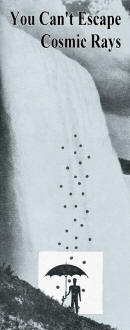
Like droplets in a waterfall, atomic particles
cascade to earth from outer space in a continuous shower, splitting as they collide.
By Martin Mann
So let's take an imaginary flight and meet more of these tiny bullets that constantly
rain down on us.
You are sitting in the rain right now - a rain of atomic particles. You cannot
see, smell, or feel them. But they are showering you and everyone else day and night,
winter and summer.
They are cosmic rays. Although they were discovered about 35 years ago, scientists
have only recently learned just what they are and a little about what they do. No
one knows yet exactly where they come from.
Although these powerful cosmic particles pass through your body every second
of your life - and they are much like the particles that come from an exploding
atomic bomb - they apparently do not hurt you. The medical men reason that the human
race, during many centuries of exposure to this much radiation, has become adapted
to it.
Cosmic rays, while very powerful individually, are spread out more thinly than
the radiation from an X-ray machine or the horrible new bomb. They are comparable,
in fact, to the drops of rain that fall at the start of a summer shower - heavy,
but widely spaced.
Recent experiments with mice indicate, however, that cosmic rays may not be quite
as harmless as most of the experts have thought. At the University of Maryland Medical
School, Dr. Frank H. J. Figge arranged eight cages of mice so that they received
varying amounts of cosmic radiation. Some of the cages were covered with lead plates,
because lead intensifies these rays. Other cages were not covered, so that the mice
in them would receive only the normal amount of radiation. Dr. Figge then injected
all the mice with methylcholanthrene, a chemical that induces cancer. In the cage
receiving the most concentrated dose of cosmic rays, 21 of the 23 mice developed
cancer in 10 weeks. In the worst of the uncovered cages, only 10 mice had developed
cancer during the same period.
Dr. Figge is careful to point out that this one experiment only indicates something
worth further investigation. It by no means proves that cosmic rays cause cancer.
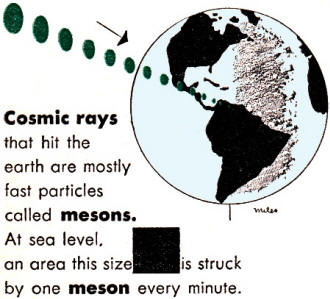
Cosmic rays that hit the earth are mostly fast
particles called mesons. At sea level, an area this size is struck
by one meson every minute.
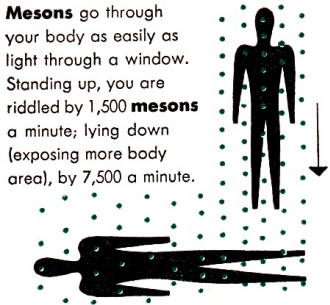
Mesons go through your body as easily as light
through a window. Standing up, you are riddled by 1,500 mesons
a minute; lying down (exposing more body area), by 7,500 a minute.
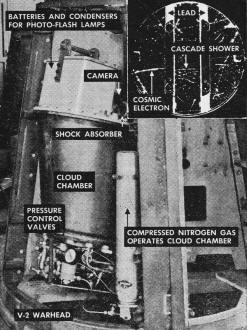
War-built V−2 rockets have become a major tool
in cosmic-ray research, taking instruments like this Naval Research Laboratory cloud
chamber to new heights. Unit shown above photographed cosmic ray tracks every 25
seconds on a 98-mile flight. Inset shows one of pictures it made. They were recovered
from film cartridge that had buried itself six feet into ground.
There are ways in which the atomic particles from out in space certainly affect
you. When they enter the upper part of the atmosphere, they transmute some of the
nitrogen there into a radioactive form of carbon called carbon 14. It is just like
the carbon 14 that is manufactured now in atomic piles. But this carbon 14 is present
in the air you breathe (as part of the carbon dioxide), and gets into your body
and stays there. Nobody knows whether this hurts you.
Such recent discoveries as this may turn out to be merely interesting tidbits
of knowledge, with no practical value. But other things learned from cosmic rays
already have proved tremendously important. Some of the knowledge that enabled physicists
to produce the atomic bomb was acquired by studying cosmic rays. So they are being
studied a lot more now, and there's no telling what will come of this work.
Suppose we take an imaginary trip - a very imaginary trip - into space to observe
this mystery with the scientists. Since we cannot see cosmic rays, we will take
a cloud chamber with us. It's a device with which the particles can be tracked and
identified. We'll also take a Geiger counter to count the rays. Our guide on this
strange tour will be Dr. Walter Heitler, cosmic ray expert from the Institute of
Advanced Studies in Dublin, Ireland, who is now a visiting professor at Columbia
University.
Dr. Heitler suggests that we follow the rays down through the atmosphere as they
approach the earth. All right, let's keep our imaginary space ship going until it
leaves the atmosphere, about 200 miles up. That is higher, of course, than anyone
has actually traveled or even sent instruments. But scientists are pretty sure that
out here, where the wide open spaces really begin, the cloud chamber will catch
the tracks of protons (the positively charged particles found in atomic nuclei)
and probably little else. Proton tracks can be distinguished from others in the
cloud chamber because a proton is about 1,845 times as heavy as an electron and
its track curves in the direction of positive charge.
These protons are the things that come from far away. Physicists call them the
"primary" radiation. They come fantastically fast, with energies as high as a million
billion electron volts. Even the new atom-smashing machines now being built (PS,
Jan. '48, p. 113) will reach only one billion electron volts.
Bombardment Increases Near Earth
Now let's follow these high-powered protons down to see what happens when they
smash into the earth's atmosphere. The air does not become thick enough to make
much difference to the protons until they're down to within about 34 miles of the
earth. Near that point, however, our Geiger counter begins to click faster, recording
an increasing number of rays. And the tracks of different kinds of particles appear
in the cloud chamber. Our space ship is now being bombarded not only by protons
but also by electrons and neutrons - two other components of ordinary atoms-and
by several mysterious particles called mesons or mesotrons.
Dr. Heitler explains that in this part of the atmosphere there are enough atoms
of air - oxygen and nitrogen - to get in the way of the high-speed protons from
outer space. As protons bang into these atoms, they knock loose their outer clusters
of electrons. And some of the protons may penetrate to the nuclei of the air's atoms
and smash them open, turning loose the protons and neutrons in their interiors.
How Mesons Are Born
The mesons, however, are actually created rather than blasted out of something
already existing. A high-speed proton passing close, to a neutron, loses some of
its speed energy. This speed energy is converted into mass (it's as though an atomic
bomb worked backwards), and a negative charge from the neutron hooks onto the new
mass. Where originally there were two fast particles, a proton and a neutron, there
are now three: a slower proton, a proton made from the old neutron, and a meson.
Mesons may also be created by collisions between two protons, yielding a meson,
a proton, and a neutron. And scientists have found, furthermore, that there are
several different kinds of mesons. The first type discovered weighed about 200 times
as much as an electron. In the last few months, however, mesons that weigh 350 and
800 times as much as an electron have been found, and the physicists expect to turn
up still other varieties, These mesons can have a single negative charge (like an
electron), a single positive charge (like a proton), or be neutral (like a neutron).
As we ride clown through the atmosphere in our imaginary space ship, the Geiger
counter clicks faster and faster. More and more of the primary protons are being
stopped by atoms of air, and more and more electrons, protons, neutrons, and mesons
are appearing around us. This secondary radiation, in turn, creates more cosmic
rays. The secondary protons, you see, produce the whole list of cosmic particles,
just as the primary ones do. And the neutrons and mesons can also ionize and break
up atoms.
You eat radioactive meals because of cosmic rays. Radioactive
carbon, produced from the air's nitrogen by cosmic rays, is in
all animal and vegetable carbon.
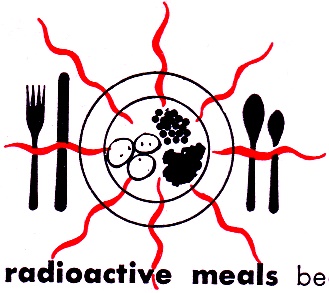
Thin metal plates intensify cosmic rays by the "cascade
effect." One meson gives a fast electron, which emits photons
when it collides with a metal atom. The photons turn into
electrons when they in turn hit atoms. Thus the number increases,
but the energy decreases.
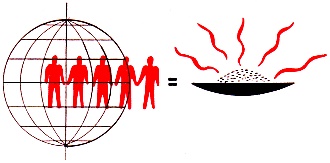
Thick metal plates cut down cosmic rays. At first, the
cascade effect intensifies them, but these cascade showers die
out inside the metal plate, lacking enough energy to continue the electron-photon
transformation.
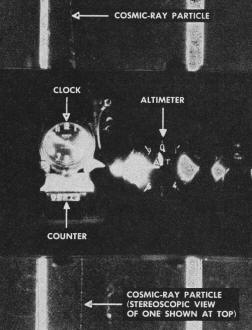
New cloud chamber developed by Dr. Robert B.
Brode of University of California makes pictures like one above. Top and bottom
sections are stereoscopic views of track of same cosmic particle, permitting measurement
of track's inclination. Center part shows clock, instruments.
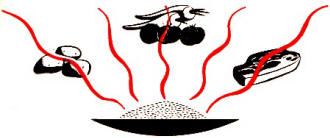
The human body also has about 10 ounces of potassium,
in which foods like these ore rich. About one port in 1,000 of this is naturally
radioactive "potassium 40".
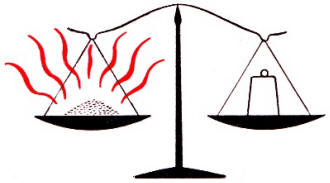
So radiocarbon from cosmic rays makes the third
radioactive substance in the body. It produces less radiation than the potassium
40 but more than the radium.
But Dr. Heitler calls our attention, as we descend, to some new kinds of pictures
in the cloud chamber. One type shows the death of a meson. Mesons, like radium and
similar substances, are radioactive. They decay into an electron and a neutrino
(a neutral electron) after a lifetime of only about two-millionths of a second.
But a little radioactivity doesn't seem to hurt us. The normal
human body even contains some radium. There's more than half an
ounce in the world's total population.
These decay electrons travel very fast, and they cause the second new type of
picture in the cloud chamber. This picture looks like a heredity chart - the streak
of a single electron branches again, and again until there is a host of new particles.
This is called cascade radiation.
Mass into Energy - and Back
In a cascade, a high-energy electron hits an atomic nucleus and emits a photon,
which is a tiny package of pure light energy. Photons consist of energy alone and
do not have weight like other particles. When they hit atomic nuclei, they change
back into electrons. Then those electrons emit more photons, and so on and on.
These processes fill the sky with particles of all kinds. This shower from the
heavens is thickest, however, about 12 miles above the earth. As our space ship
moves down lower than that, Dr. Heitler points out that the Geiger counter registers
fewer and fewer particles because the atmosphere is becoming dense and the cosmic
energy is thinning out. By the time we reach the earth, the tremendous energy originally
present in the primary protons has been divided and redivided so many times that
relatively few individual particles are powerful enough to continue through the
air, and the Geiger counter clicks only a few times a second. Most of these clicks
are caused by mesons.
If we unloaded the Geiger counter and cloud chamber and carried them down into
a coal mine, Dr. Heitler adds, we would find that the cosmic rays lessened as we
descended, because the earth too absorbs them. About a mile below ground, the rays
would disappear almost completely.
Learning these things has taken a long time, much expert craftsmanship, and some
very fancy head-scratching. About 50 years ago, when Becquerel and the Curies found
that certain elements were radioactive - that is, that they emitted strange particles
- scientists began to look for radioactivity in whatever was handy, even the air.
They found it, too. So they supposed that there was a trace of some radioactive
substance in nearly everything - the earth, air, water, buildings, and so on.
Then a couple of very inquisitive fellows, Y.F. Hess of Austria and W.H.V.
Kolhörster of Germany, sent their instruments up in a balloon. They reasoned that the radiation
detected should diminish as the balloon went farther away from the earth. But it
didn't. The higher the balloon rose, the more intense the radiation became. So there
was only one plausible explanation: the radiation came from somewhere out in space.
A Japanese physicist, Hideki Yukawa, was responsible for the next big advance,
though not working on cosmic rays at the time. He was trying to figure out why the
nucleus of an atom stays in one piece. His computation of the force necessary to
hold it together revealed that it was a type of force that could be represented
by a particle. That particle, he said, should weigh about 200 times as much as an
electron, have a single negative charge, and last only a few millionths of a second.
So the cosmic-ray experts began looking for such a particle, and Dr. Carl D.
Anderson of the California Institute of Technology soon found it. Dr. Yukawa had
forecast the existence of mesons.
The most recent discoveries resulted indirectly from World War II. Two of the
deadliest weapons ever devised, the B−29 plane and the V−2 rocket, enabled the physicists
to measure cosmic rays at altitudes higher than were previously attainable. '
Flights by Dr. Anderson in a B−29 made a pretty sure thing out of what had been
a strong suspicion: the basic radiation from out in space is almost exclusively
protons. And V−2 experiments directed by Dr. James A. Van Allen of Johns Hopkins
University settled another years-old question: where does the cosmic-ray intensity
level off? A 100-mile flight last July finally pegged this point at 34 miles up.
More Puzzles to Solve
There are still a lot of cosmic-ray puzzles for smart young men to answer. The
most intriguing is the problem of where these rays come from. Most scientists believe
they come from far outside our solar system - maybe some place in the Milky Way.
There are other theories, too, such as the "solar cyclotron" proposal of Winfield
W. Salisbury, research director of the Collins Radio Co., and Dr. Donald H. Menzel,
Harvard astronomer. They suggest that the movement of atoms in the sun generates
very long radio waves. These radio waves then accelerate particles that exist in
space near the earth - in much the same way particles are accelerated in a laboratory
cyclotron.
But more evidence is needed. How long it will take the scientists to obtain it
no one knows. But the planes and rockets that may help them tremendously are being
developed now. Scientific progress, like cosmic radiation, is overtaking us day
and night, winter and summer.
Posted January 16, 2024
|